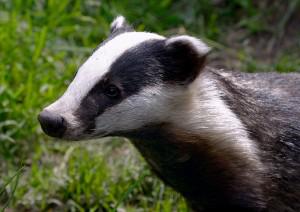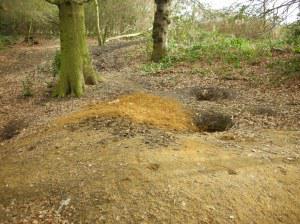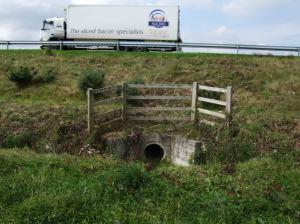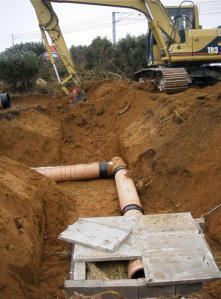
Badger (Meles meles)
Badgers, or Meles meles, are endemic to most of the United Kingdom but are rarely encountered by humans as they are primarily a nocturnal animal. They are stocky, with a rotund body and short legs and as such cannot move particularly fast for long periods but have been known to sprint up to 30km/h. They are creatures of habit and will continue to use established routes to forage or access water even when dangerous obstacles are placed along their route. They avoid contact with humans but can be dangerous if cornered as their claws are sharp and strong and their jaws are incredibly powerful. They will accumulate fat reserves in late summer and autumn but will not hibernate during the winter. Instead they simply limit their exertion and not venturing above ground very often during the winter months, staying below during periods of low temperature or heavy rains. They will have a number of setts close to the main sett and the most heavily used will have well worn trails between each other and areas of forage.
How to Identify a Badger Sett
Badgers will prefer woodland or dense hedgerows and their setts can vary greatly in size; some main setts can have up to 40 entrances, some may have only 2. Setts can be used seasonally or all year round. The entrances are usually wider than they are tall and have remnants of vegetation and pilled earth mixed with badger hairs nearby in heaps. Badger footprints are broad, much broader than foxes. Badger and fox footprints may both be found at the entrance to a sett as occasionally they share the same sett/ den.
Badgers may also inhabit man made constructions such as sheds or concrete pipes, especially when the land is waterlogged. These constructions are then given the same legal protection as sets.

Badger Sett
Badgers may only spend one night in a sett before moving to another, returning to the original sett at a much later date. As a consequence surveys should be carried out over a period of time, particularly in winter when they may not venture above ground for long periods of time. Any hole above 250mm in diameter should be considered as a possible sett and investigated thoroughly.
A competent developer should appoint an ecologist to identify if there are any protected species on a site before any destructive operations take place on a site. The ecologist will identify if there are any active setts on site and advise the developer of their options regarding the presence of Badgers. This will ensure the developer stays within the bounds of the law. Any protected species found on site can either be relocated at the appropriate time of year or their habitat can be protected or enhanced and incorporated into the development proposal.
The Legal Protection of Badgers
Under the Protection of Badgers Act 1992, badgers and their setts have the following protection. It is an offence to:
- Wilfully kill, injure, ill-treat or trap badgers
- Intentionally or recklessly damage, destroy or obstruct setts which show signs of current use by badgers, including seasonal use
- Disturb badgers whilst they are occupying a sett
- Cause a dog to enter a sett.
The main problem when dealing with badger setts and construction is in the unknowing ill-treatment of badgers; of special note are their routes to forage and water as they will not easily find new routes when they are obstructed. As good practice all new developments that deal with badgers should incorporate:
- A buffer zone, usually of 30m, between a sett and work area/buildings, with fencing and/or clearly marked with protective planting
- Location of roads and footpaths well away from a sett, with protective planting.
- Location of drains and underground services away from the sett
- Replacement of lost foraging areas by provision and appropriate management of alternative open space
- Greenways, such as hedgerows and planting along footpaths/cycle ways, to allow badgers to reach feeding areas
- If road tunnels are impractical, the use of reflectors on the road edge can help to give badgers advance warning of approaching vehicles.
- The local badger group should be consulted if badgers may be disturbed within a sett to ensure that any risk of disturbance or injury is kept to a minimum. If such a risk exists a suitably experienced person should be on hand to advise.
- Noisy machinery near setts should be used before mid-day, if possible, to allow badgers to settle down afterwards so their normal foraging activity is not disrupted any more than necessary.
- Where badgers may be forced to move from the sett or place of shelter because the structure is being dismantled, the work should be carried out as late in the day as possible to avoid badgers being bolted above ground in broad daylight.
- Scrub clearance should be avoided over the tops of setts and close to sett entrances.
- Trees and shrubs should be felled away from the obvious direction of a sett and should not be uprooted but cut to ground level where necessary.
- All trenches left open overnight should include a means of escape for any animals that may fall in.
- Buildings and structures, such as sheds, may have to be dismantled, but in such cases the floor should be left in place, if possible, if it forms the top of the sett.
- Fires should be lit at the furthest distance possible from the sett.
- Road crossing points using tunnels or culverts with associated badger-proof fencing – for busy roads crossing a well-established badger path

Badger tunnel under road
- Obvious badger pathways should be left clear of obstruction.
- No dogs should be taken onto the site by any of the workforce.
- Reinstatement of sett damage should be under the guidance of an experienced badger worker.
- If the sett area is to be marked off to avoid interference, this should be done with rope, fencing or wire. Plastic tape can be very disturbing to badgers in windy weather and should be avoided.
- Where it is necessary to walk over the top of a sett, planking should be provided to spread the load if the soil is very light, or there is a chance of sett collapse.
- All work should be carried out as quickly and quietly as possible.
Licences may be granted by Natural England for work that would otherwise be illegal. Licences may be granted for:
- Preventing serious damage to land, crops, poultry or any other form of property (e.g. a house, garden, road etc.)
- Any agricultural or forestry operations
- Any operation to maintain or improve any existing watercourse or drainage works, or to construct new works required for the drainage of land, including works of defence against sea or tidal water
- Preventing the spread of disease
- Development
- Controlling foxes in order to protect livestock or penned game
- Ringing and marking
- Scientific or educational purposes, or conservation
- Preservation of ancient monuments or an archaeological investigation
There are 2 types of licence, which must be obtained before any work goes ahead:
- Licences from English Nature for new development
- Licences from DEFRA for all non-development matters. These include problems caused by badgers on existing roads and rights of way.
There are a number of statutory defences under the Act, relating to mercy killing and incidental disturbance or damage to setts where this is unavoidable. As a guide for developers, the following activities may require a license from English Nature:
-

Badger Sett Construction
Using heavy machinery within 30 metres of any entrance to an active sett
- Using lighter machinery, particularly for digging, within 20 metres of any entrance to an active sett
- Light work such as hand digging or scrub clearance within 10 metres of any entrance to an active sett
These licences may also be provided with conditions such as providing an alternative sett six months or more before construction or enhancing forage and routes both before and during construction. They will also usually be restricted from December to June due to breeding and rearing of badger cubs.


